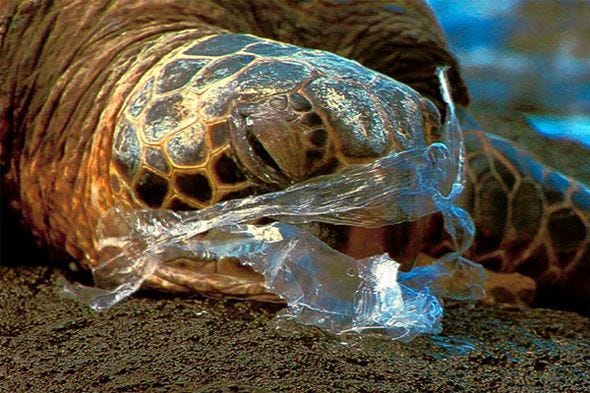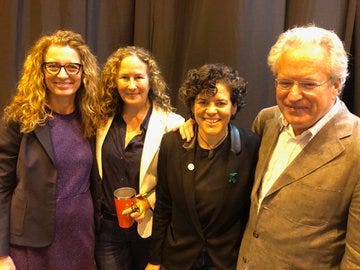Straw Wars
Straws are a gateway drug, because they are so easy and ubiquitous. That is also what makes them a gateway solution, or “sipping point.”

500,000,000. Five with eight zeroes. That is how many plastic straws go into drink cups. Not every year, that’s every day. And that’s just in the USA.
I can almost remember my delight as a child when a friend showed me how to take of the end of the paper wrapper and blow the wrapper at some unsuspecting target across the room. That was half the fun of straws when you were a kid. The other half was making noises and bubbles in the bottom of the cup.
The plastic story is relatively recent. The oldest straw still intact and in a museum was discovered in a Sumerian tomb dated 3,000 B.C.E. — a gold tube inlaid with the precious blue stone lapis lazuli. It wasn’t until the late 19th century era of extravagant world expositions that people started making paper straws — wrapped in wax to keep them from dissolving in gin or bourbon. After World War II we started to see plastic. I am old enough to remember the Flav-R-Straw, a bendy straw with hundreds of tiny flavor pellets in the bellows that could turn plain milk chocolate or strawberry.
Flav-R-Straws were withdrawn in 1961 after Nestlé Quik, Bosco and Hershey’s countered with products they could back with full-spectrum market dominance. Tiny Flav-R-Straws were crushed.
Early paper straws had a narrow bore similar to the grass stems used for millennia. It was common to use two of them, to reduce the effort needed to take each sip. Modern plastic straws are made with a larger bore so only one is needed for ease of drinking, but when they hand you your 64-oz Biggie through the drive-up window, chances are it's got two, purely out of habit.
And it's single use plastic.
You can complain and they will take back the straws, but when you aren’t looking those are going straight into the trash, which goes straight into a dumpster (in a plastic bag), which goes maybe to separation and maybe not, and then to either landfill or to some watercourse that leads to the ocean and thence the gullet of seabirds or the digestive organs of fish, turtles, dolphins or whales. Robot subs have found that plastic in the stomachs of creatures in the Mariana Trench, 36,000 feet down.
Between 88 and 95% of the plastic polluting the world’s oceans pours in from just ten rivers, eight are in Asia and the remaining two in Africa. These rivers account for about five trillion pounds of plastic garbage that is floating in the seas. It kills an estimated 200 million marine mammals annually.
The Ganges River in India is responsible for about 1.2 billion pounds, while the Yangtze has been estimated in previous research to dump some 727 million pounds of plastic into the oceans each year.
A combination of the Xi, Dong and Zhujiang Rivers (233 million lbs per year) in China as well as four Indonesian rivers: the Brantas (85 million lbs annually), Solo (71 million pounds per year), Serayu (37 million lbs per year) and Progo (28 million lbs per year), are all large contributors.

Panelists Naja Nielson @OrbTweet, Dianna Cohen @PlasticPollutes, Jackie Nunez @NoPlasticStraws and Jon Bowermaster @NatGeoMag at #CollisionConf
We had the good fortune this week to meet Jackie Nunez, founder of The Last Plastic Straw. She called straws a gateway drug, because they were so easy and ubiquitous. That is also what makes them a gateway solution, or “sipping point,” as Nunez tells it.
She made an invitation to all bars and restaurants to be part of her movement to eliminate plastic pollution from the source. By simply stating on menus “Straws available upon request,” bars and restaurants can be part of the solution.
Jackie said, “I had my Last Plastic Straw moment in 2011 after receiving a glass of water with a plastic straw at a local beach side bar in Santa Cruz, California. I didn’t ask for a straw. I had just arrived into town after traveling the Caribbean. While there, everywhere I went I saw plastic pollution. On the beaches, in the water, on land. Plastic pollution was everywhere, there was no getting away from it. There is no ‘away.’”
After unloading on her waiter, she decided to be more strategic and that is when she started The Last Plastic Straw. “Basically what we are asking you to do is DO LESS…less consumption, less waste, less straws, it’s a win, win!” she says.
Check our Resources pages for plastic straw alternatives, inspirational reading and videos that will provide insight and solutions that you can incorporate into your life right now.
Join us, by spreading the word every time you ask for “no straw” whereever straws are served, and by requesting that restaurants & bars only serve straws upon request. Start living like you love the ocean, yourself, and the planet. You will help save the planet from single use plastic pollution one straw at a time. Little things do matter. Go to our facebook page and tell us about your “Last Plastic Straw Moment”…hopefully it’s today!
Thanks to Jackie, from London to Miami, restaurants, bars and cities are banning plastic straws voluntarily. When you return yours to your server, you should politely instruct them to:
- Provide a straw only when requested by a customer
- Provide either compostable or reusable straws
- Or get rid of straws completely
On April 19, 2018, ahead of Earth Day, a proposal to phase out single-use plastics was announced during the meeting of the Commonwealth Heads of Government. This will include plastic drinking straws, which cannot be recycled and contribute to ocean deterioration, damaging ecosystems and wildlife. It is estimated that as of 2018, about 23 million straws are used and discarded daily in the UK. And the alternatives are literally grass roots.
A few months before, Queen Elizabeth II banned the plastic straws and other one-use plastic items from her palaces. Canada is now considering banning straws nationwide after 70% of voters polled endorsed a plastic straw ban.
How hard would it be, after all, to go back to paper? Now, embed that paper with biochar and you are really talking my language.


Comments
Sugarcane straw is also a kind of straw, made by Ecolo. it is even better than any plastic or 紙ストロー.